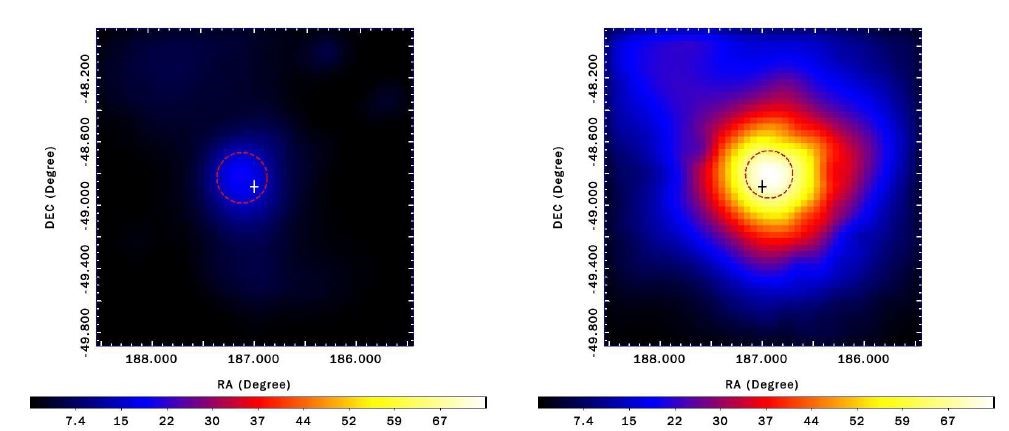SHAO’s progress on the second transitional pulsar binary
SHAO astronomers have studied the emission properties of the second transitional millisecond pulsar binary in the gamma-ray band. Combining other multiband information, they have revealed the physics behind the transitional phase.
Discovery of the first transitional pulsar binary was more like rational inferences from coincident observations. The first transitional millisecond binary, J1023+0038, was discovered in an un-targeted radio survey in 2009. Taking other multi-band observations in the last few years into consideration, astronomers realized that there was an accretion disk in this system around 2001 and after 2002 the disk disappeared. What makes this story more interesting is the observation made in June 2013 --- astronomers found that the disk appeared again.
Currently, Prof. Zhongxiang Wang and his team took a detailed research on the second transitional millisecond pulsar binary XSS J12270-4859, especially on its poor-studied gamma-ray spectrum during this stage. Using the Fermi’s data, they found that after the disk-disappearance, emission in the Fermi’s 0.2-300 GeV decreased by a factor of 2 and showed a weak orbital modulation similar to that found at X-rays. At the time, the team suggests that the modulation possibly arises due to the occultation of the gamma-ray emitting region by the companion. This work has been published in Astrophysics Journal on July 2015.
Let’s first look at astronomers’ investigations on this target.
Discovered by the X-ray survey, XSS J12270-4859 was initially thought as a cataclysmic variable. Later it was revealed as a low mass X-ray binary system associated with a gamma-ray source 2FGL J1227.7-4853.
From radio observations, its radio pulse period (the period of its spin) was reported as 1.69 milliseconds. From optical data, its orbital period (the period of its co-rotation with its companion star) was found as 6.9 hour and the mass of its companion is between 0.06 and 0.12 solar mass. Astronomers noticed that its X-ray emission became fainter by a factor of 2.5 after the disk-disappearance. Besides that, X-ray orbital modulation was detected. While at gamma-ray energies, except a possible flux decrease being reported in an astronomer’s telegram, no other extensive observational studies were conducted.
Dr. Yi Xing, the first author of this work checked the gamma-ray data for all sources within 16 degrees in the Fermi second source catalog centered at the position of the source XSS J12270-4859. They found that during the time periods both before and after the disk-disappearance transition, the emission of the source XSS J12270-4859 can be described by a similar function (technically speaking, an exponential cut-off power law) with different shapes and amplitudes.
“After the disk-disappearance, the gamma-ray emission was fainter by almost a factor of 2.” Besides that, a weak orbital modulation was seen after the transition, similar to that found in X-rays. Prof. Wang further explained, “An intra-binary shock is probably formed due to the encounter of pulsar wind with outflow of the companion. High energy emission arises from this shock region. The orbital modulation may arise due to the occultation of the photon emitting region by the companion. ”

Figure: The TS maps of a 2 degrees * 2 degrees region centered at the position of XSS J12270-4859 at different optical orbital phases. Colors from red to blue means increasing TS values, referring larger possibility that a gamma-ray source may exist here. The white and dark crosses mark the 2MASS position of XSS J12270-4859, and the dashed red circle indicate the 2 sigma error circles of the best-fit positions of the candidate gamma-ray source 2FGL J1227.7-4853.

Figure: left panel: gamma-ray spectra of 2FGL J1227.7-4853 obtained before (blue data points) and after (red data points) the disk-disappearance transition. Right panel: gamma-ray spectra of 2FGL J1227.7-4853 obtained during the high (TS values not smaller than 35) and low (TS values not greater than 20) states.
By analyzing the gamma-ray spectra before the disk-disappearance, the team discovered flux variations. “The origin of the flux variation is not clear yet, as the source field also contains unidentified radio or X-ray sources and their contaminations cannot be excluded. Multi-wavelength observations of the source field will help to solve this problem,” says Prof. Wang.
Link to the research paper: http://iopscience.iop.org/0004-637X/808/1/17/
Scince contact: Yi Xing, yixing@shao.ac.cn Zhongxiang Wang, wangzx@shao.ac.cn
News contact: Wenwen Zuo, wenwenzuo@shao.ac.cn, 021-34775125
Download attachments:


